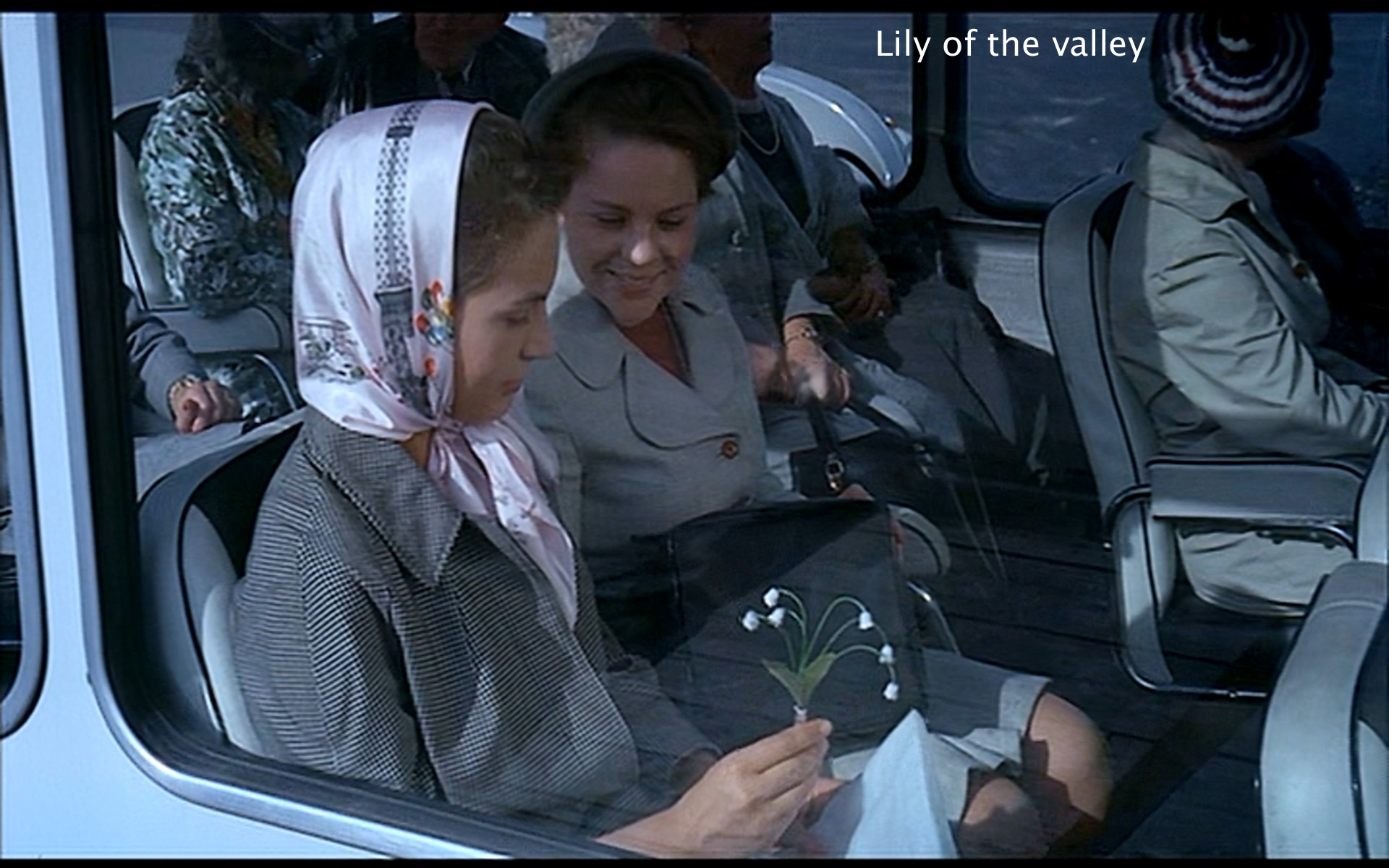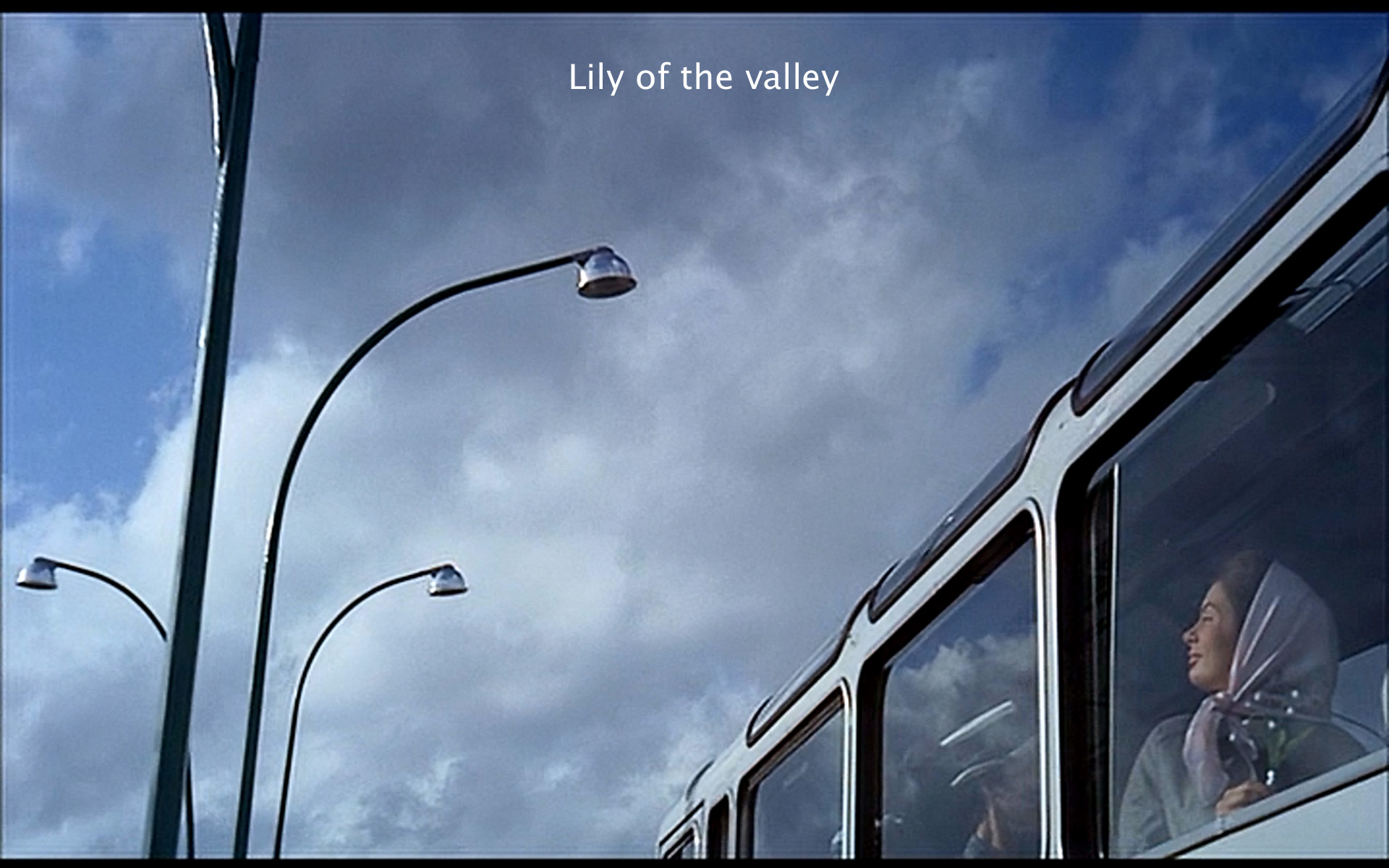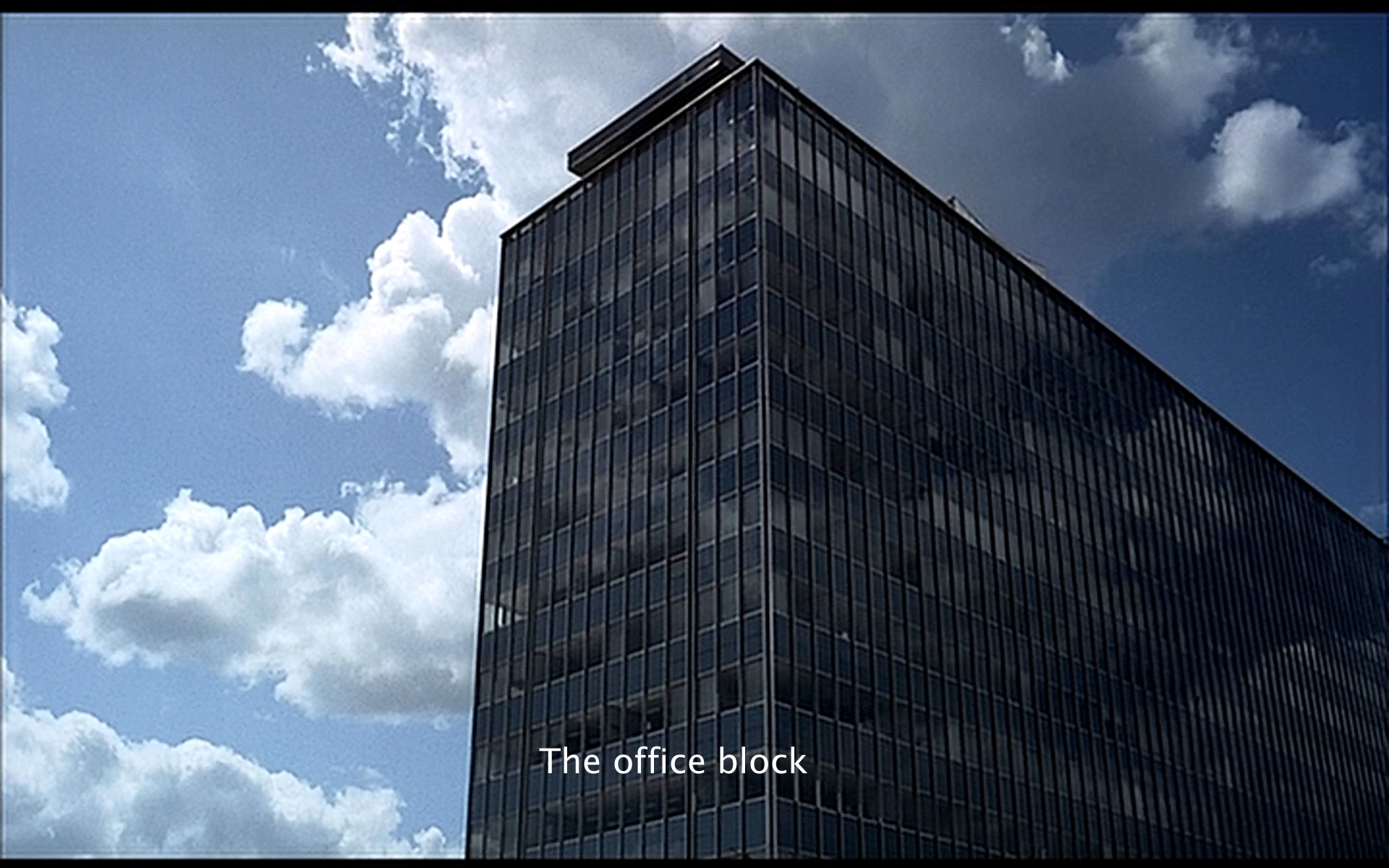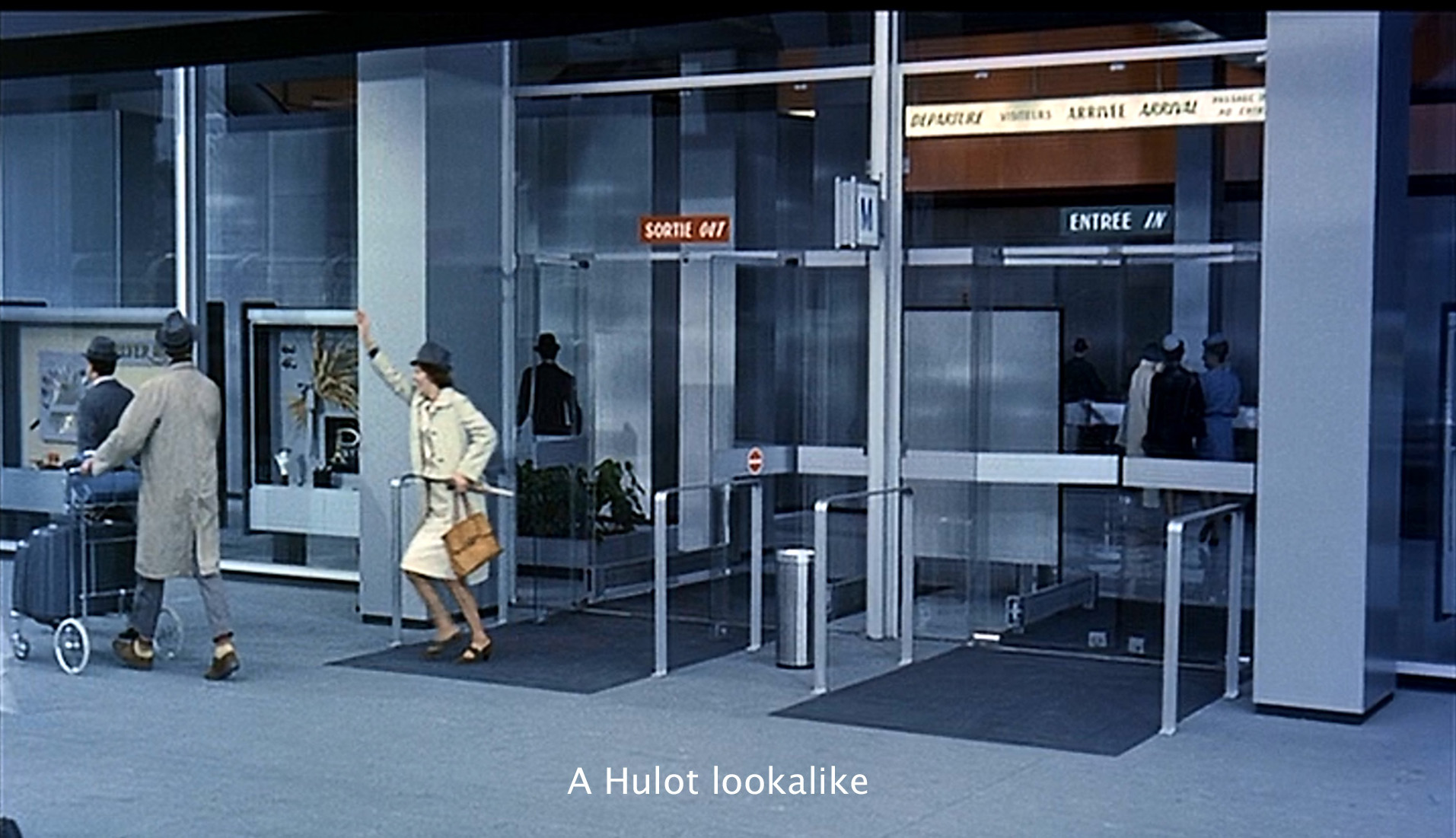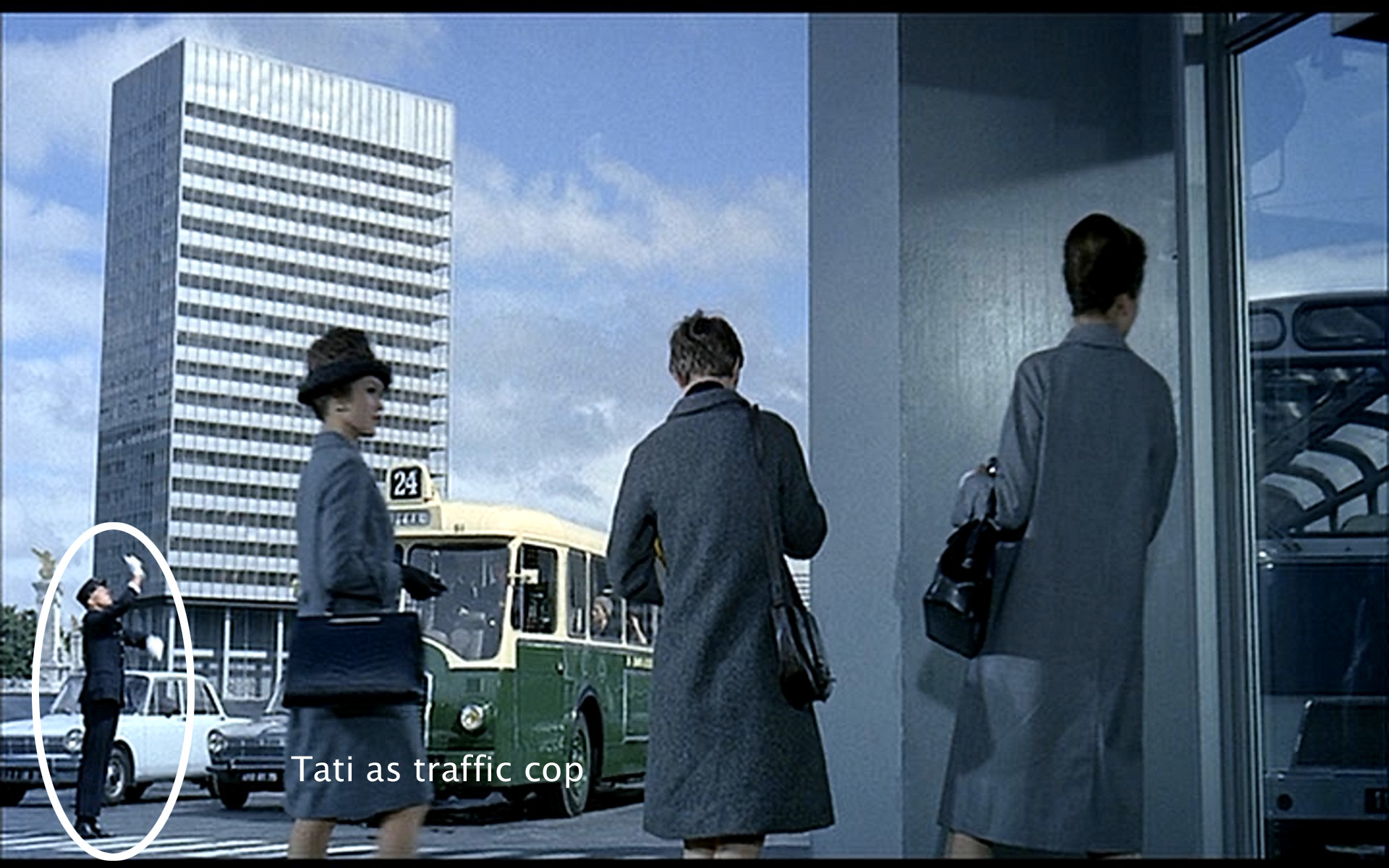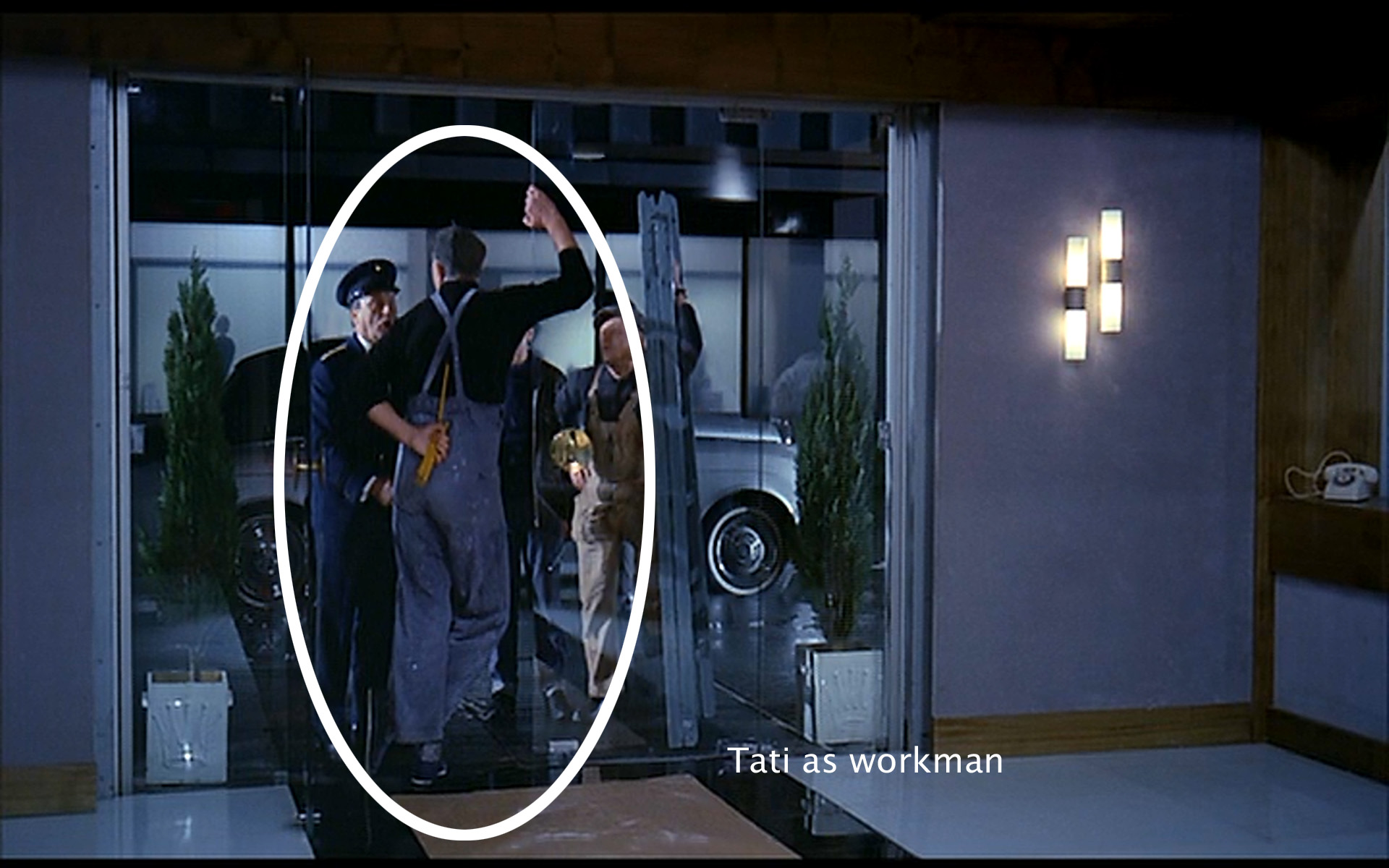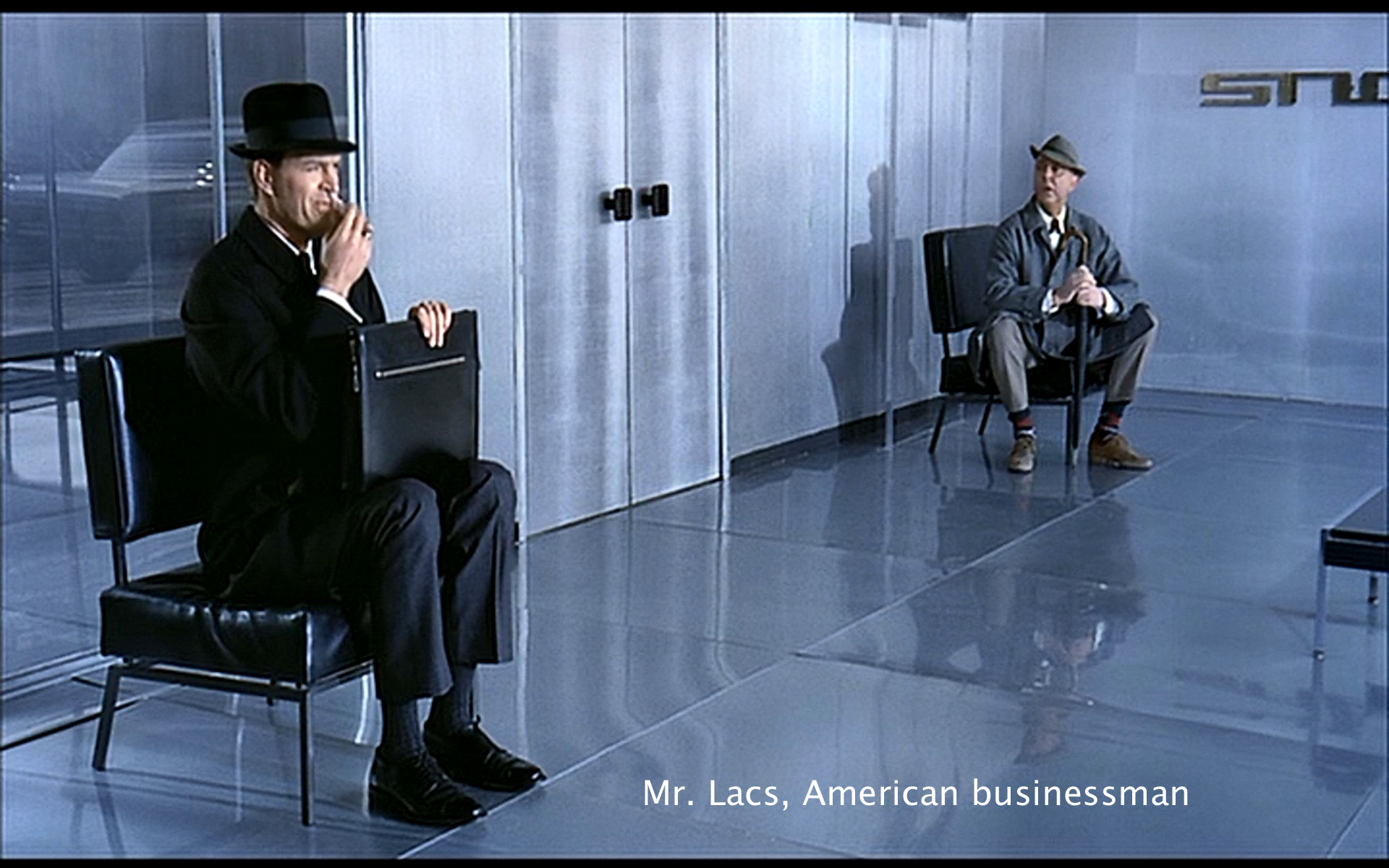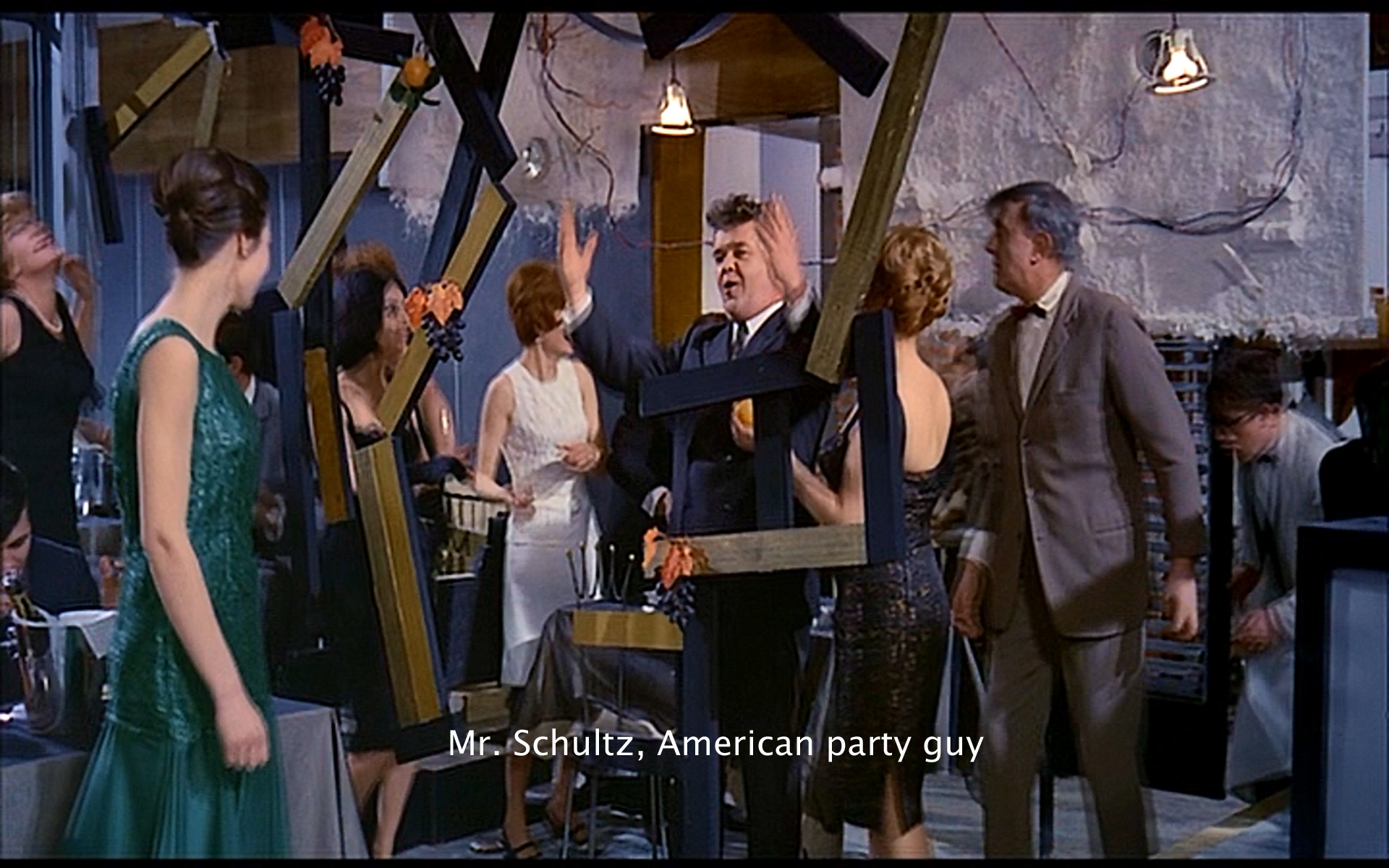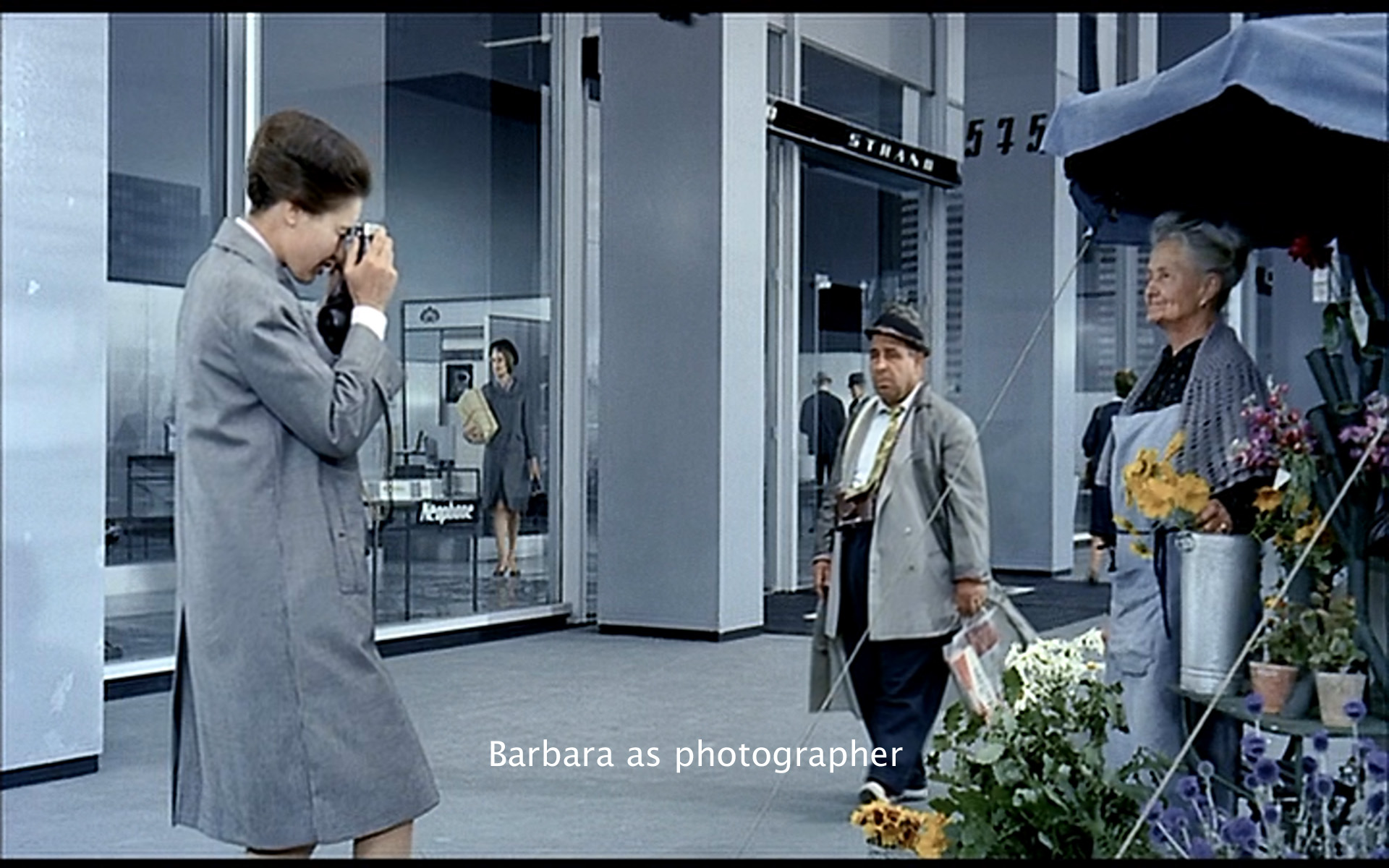One tiny episode lodged this movie in my heart forever. Near the end, M. Hulot (Tati himself) buys a going-away gift for Barbara (Barbara Dennek) as she is about to leave Paris with her tour group. He buys her a scarf and manages to get one of his look-alikes to deliver it, he being blocked by his usual faux-pas. She opens the box and puts on the scarf, thus covering her head like the nuns in the opening. Deeper in the box she finds a sprig of lily of the valley. (The French give sprigs of this flower, muguet, on the first of May; hence this may date the movie.) Tati cuts from the lily of the valley to the street lights that the bus is driving under. The street lights "rhyme"--look like--sprigs of lily of the valley, and they were the first thing the tourists saw of Paris. (Kudos to critic Philip Kemp for pointing this out in his commentary on selected scenes on the Criterion disk).
It is as though Hulot, as his parting gesture to Barbara and the film, has given her--and us--an emblem for the City of Lights, Paris, itself or perhaps Tati's own sweet acceptance of humanity's foolishness. The film finishes with a stream of cars (Tati's preoccupation with traffic and transport again), their taillights disappearing into the night. Goodbye.
It very nearly was goodbye, Tati. Most people who write about Play Time tell at length the astonishing, sad story of Tativille, the huge movie set--a city of streets and buildings-- that Tati constructed at immense cost. A combination of bad weather and Tati's prodigal shooting habits led to financial disaster. He insisted on making this movie in 70mm., so that many comic bits take place in the background or at the sides of the big screen. His American distributor wouldn't handle the film. Tati lost everything, including the rights to his own movies and even his sister's inheritance. He was barely able to make his last feature, Trafic. Sad, even tragic, as this was, it doesn't tell us why and how Play Time remains a comic masterpiece.
That so tiny a detail as that "rhyme" of a sprig of muguet with the streetlights should offer so rich and emotional a reading shows how carefully Tati arranged and filmed every little bit of this movie.
I always urge you to look carefully at the opening and closing shots. Play Time begins with some shrill jazz contrasted to fleecy, slightly moving clouds over which the opening credits play. Tati cuts abruptly to a big, black office building. I think Tati is making a pun in French. This is an immeuble, literally an immovable. The British term also applies, an office block. It is something that interferes with movement, and that is one of Tati's favorite themes, running all through this film: transport and movement. He titled his next feature, Trafic, or what the French call, circulation. From the "block," cut again to two nuns walking in unison, making a strict right angle (an introducing Tati's favorite theme, movement, a contrast to that big, black block). They turn into what looked, to me, like a hospital. After all, it is very institutional. II saw the nuns, a woman dressed like a nurse carrying towels, a janitor, a man who looks like an orderly pushing a hospital cart. In the foreground a woman fusses over her husband who is perhaps being admitted. But as other figures appear, an army officer, a band of school children, then chimes sound, I realized, No, this is an airport, the first of many surprises in Play Time.
Also, we have entered the first half of the picture. In it, M. Hulot tries to meet an American in this office building. Instead, he gets lost, interrupts a meeting, causes all kinds of confusions in a housewares exposition, and so on, until night falls and we go to the second half of the film.
And we are now thoroughly entered into Tati's theme of "traffic," people's moving here and there in cars, boats, planes, bicycles, horses--any kind of transport. "Transport," by the way, is the psychologists' term for our being "carried away," lost, in a work of art like a movie.
The closing of the movie continues the idea of transport and movement. Barbara receives her gift and covers her head with the scarf like the nuns at the beginning. And then she gets the lily-of-the-valley. The bus seems to rise and fall as a workman reflects it in a glass he is cleaning. We go to a clogged traffic circle. (Tati has described the subject of this movie, in a BBC interview, as going from straight lines to zig-zags and circles. One of the French words for traffic is circulation.) Finally, the film ends with night time and the taillights of cars moving off toward the lights of Paris, the City of Lights.
As part of this world of constraint, guides herd the American tourists here and there. They are enduring (and, ugh! enjoying) one of the American Express-type tours: "If it's Tuesday, then this must be Brussels." A day here and a day there, and apparently just one day in Paris. One day in Paris and you spend it looking at housewares? What a shame!
Among these Americans, mostly women, the film singles out "Barbara" (played by a German non-professional, her American English dubbed). Like Martine in M. Hulot's Holiday or the concierge's daughter in Mon Oncle, she is the amused onlooker. She is, in one sense, a surrogate for us. She demonstrates for us the attitude of tolerant enjoyment that we should adopt (as Tati does) toward the human foibles that he films for us. But she also takes pictures, and, with her camera, she is, like Tati, a perfectionist. In that sense, Barbara mediates. She stands both for us and for Tati. She stands between us, an outsider whom we watch, yet someone we identify with. She is a connection.
In large part Play Time is about our human need to make connections with other humans as tourists, as business people, customers, and so on. Doors allow connections, and Tati plays constantly with doors in this film. There are all the confusing glass doors in the office block, the non-door to the night club, and a door that makes no noise when you knock on it (in the housewares show), plus any number of doors that go thu-u-u-ng. There is even a character derived from doors. The fussy little M. Giffard (Georges Montant) is a huissier, a functionary in French government and business buildings who opens and closes doors (les huis) and runs other errands. He is supposed to lead Hulot to his appointment with some American somewhere in the depths of the huge office block, but of course he never does. Instead he bangs his nose on, what else?, a glass door.
Glass would seem to let us make connections, but here it only adds to the confusion with reflections that create the illusion of connection: the glass panels and doors of the office block; the windows of the tourists' bus; the "real" Paris reflected in glass. Shattering the door of the night club begins the shattering of these illusory connections, replacing them with real connections.
Tati also connects things with his color scheme. He used a strict color scheme for the first half, steely blue, beige, gray, white, black--office colors. He deliberately kept red out. Whenever you see something red in this film, it is special and important: the red light in the dreadful panel for announcing visitors; the red rosettes of the Legion of Honor worn by the executives in the big photos in the waiting room; the red dessert in Le Drugstore (part of Tati's food theme).
Tati ties things together, too, with his characters. Some of the people from the first half, notably the executives in the huge photos in the waiting room, turn up in the restaurant in the second half. Similarly, "Royale" turns up as the Café Royale, the fancy restaurant, as the Royale Garden, a landscaper's truck, and as the Hotel Royale where Barbara is delivered.
Electronic devices, telephones, loudspeakers, and television sets--they too seem to connect people, but don't, really. By contrast, Hulot's army buddies who keep popping up represent a real connection. Sort of. His friend with the transparent apartment, a box among other boxes, offers television, a slide show, drinks, but the poor man is hopelessly boxed in. Hulot just wants to escape.
Speech connects. The sound track of the film is international: people speak French, German, English, sometimes all at once (the German executives). And then there are the Americans.
As part of his concern with connections between people and nations, Tati plays with the Americanization of Europe and, in particular, Paris. This was a time when many Americans found it feasible to travel to Paris. (My own first trip took place in 1969.) Tati gives us three types. Tati's first American is Mr. Lacs (John Abbey), an American businessman obsessed with neatness and business. He joins M. Hulot in the waiting room, but he is all efficiency as opposed to M. Hulot who is all bumble. Lacs turns up later in the restaurant.
The second American is Mr. Schultz (Billy Hearns), a prototypical Ugly American. He is loud, rude, intrusive and abusive. He throws his money around. But he turns out to be the joyous Bacchus who provides the party spirit for the second half of the movie. And he won't let Lacs into the impromptu bistro he sets up. Too preoccupied with business.
The third American type is Barbara, the admiring tourist, and her gaggle of American ladies who ooh and aah when they should (and when they shouldn't--at the housewares). Passive, throughout the film they are moved from here to there.
Certainly, one of Tati's major themes in this movie as in his others is movement. People walk, run, drive, ride busses, or take elevators and escalators. People in this film are always in motion, always looking for something. M. Hulot spends the whole day going here, there, and everywhere trying to find the American with whom he has an appointment. At key points in the film we see cars trying to make their way through Paris' traffic. Tati has described this film as going from straight lines at the beginning to circles and zig-zags at the end. Certainly we get to a notable traffic circle in the ending. By contrast, we open with that big, black block of an office building, immovable. We close with cars' taillights going into the night and the lights of Paris.
We could think of Tati's preoccupation with motion as like the themes of two of the philosophers of his era, Henri Bergson's élan vital or Benedetto Croce's idea that everything is process or activity.
Tati is being more neuroscientific here than he could possibly know. This business of humans constantly moving, seeking something--we share this foraging tendency with other mammals. That is because we all have the mammalian brain, which has a dopaminergic network that drives us into motion. Cells in the ventral tegmental area and the substantia nigra, deep in the brains of all mammals, spritz dopamine to the action and emotion regions of the front brain. This dopamine system responds to stimuli that predict rewards, not to the rewards themselves. The system is active all the time during the day and during REM sleep. It generates search activities: foraging, investigating, sniffing, and probably dreaming. Like a rabbit or a rat or a raccoon, we humans are driven to seek. And what do we seek? Like other animals, food (available at Le Drugstore). Like other animals, a mate (Barbara). And, humans being primates, social animals, we seek connection with other humans.
That dreadful turbot à la Royale, seasoned and re-seasoned, sauced and re-sauced, and flambéed, but never eaten. In fact people have a lot of trouble getting food in that restaurant. Food you get at le Drugstore, the eatery on the corner. That is the third and final phase of the film, the stage when these humans who are, after all, biological creatures who need to eat, finally get fed. In le Drugstore and the supermarket, they get food! At last!
This third phase of Tati's film comments on the other two. In the first, modernity, its architecture and machines and communication, controls and constrains the humans in it. In the second phase, the crazy restaurant, the humans break down the architecture in their "Play Time" after working hours. But in the third phase, they come to terms with their biological animal nature. They eat and drink and flirt.
Tati shows us moving and seeking, yes, but when we get to what we were seeking, it often turns out to be something else. People came to this movie expecting to see a "Hulot movie." A few minutes into the film a lady recognizes M. Hulot as he is walking by and calls to him. But it's not Hulot, it's one of a half-dozen lookalikes in this film. Conversely, Tati appears in non-Hulot roles. I spotted him as a traffic cop and as the tall workman fumbling with the door to the Café Royale. There are probably others. Putting the star in the background or his having his back to us--these are ways Tati democratizes his big screen. Tati's sound track also provides surprises everywhere, emphasizing what is often scarcely noticeable on the screen.
From America, we don't get what we expect. We expect business; we get bacchanal. The Ugly American turns out to be the Fun American. The American tourists are supposed to be seeing Paris, but they are delivered to a housewares exposition instead. The real Paris, we see only as reflections. As for the travel posters for London, Mexico City, and elsewhere, they show only the grim office block with which the picture began.
The Café Royale, acme of upper-class modernity, scarcely manages to serve any food. But in the third part of the movie, the little coda to the riotous party in the Café Royale, workmen and society types mingle, both driven by the common human, biological imperative: we have to eat. And we need to love--hence Hulot's little gift to Barbara, no matter how clumsily delivered.
Perhaps the most surprising thing occurs as the characters exit the Café Royale. As if to signal a turn toward biological reality, a totally improbable rooster crows. The characters amble into Le Drugstore, looking for food. This final scene provides a coda to the film. You could see this film simply as spoofing modern architecture and the regimentation of modern industrialized life. We see its nastiness and foolishness, and then the film breaks it down as the big Café Royale disintegrates into the joyous little bistro Mr. Schultz has set up in one corner. But that would be too simple. The expected theme of the film turns into the unexpected. Tati returns us (as he does in Mon Oncle) to our ordinary animal humanity: we need food and we need love. Foolish as either the huge office block is or the Café Royale, they are all part of being human. The unexpected ending of the movie is really quite expectable. It represents Tati's gentle acceptance of our foolishness that raises Play Time to the heights of comic understanding.
